Characterization of New H-Bonded Liquid Crystalline Complexes Based on Iminophenyl Nicotinate
Abstract
:1. Introduction
2. Experimental
2.1. Preparation of 2:1 SMHB Complexes
2.2. Computational Method for Calculations
3. Results and Discussion
3.1. FT-IR Confirmation of SMHB Complexes
3.2. Mesomorphic and Optical Studies
3.3. DFT Theoretical Calculations
3.3.1. Molecular Geometry of SMHBCs
3.3.2. Molecular Electrostatic Potential (MEP)
3.4. Photophysical Studies
4. Conclusions
- The isophthalic acid complex (I6/A) exhibited an induced enantiotropic SmA phase with a broad range of stability followed by the N mesophase.
- The terephthalic acid complex (I6/B) was shown to possess only the nematic phase.
- The SMHBCs of the isophthalic and terephthalic acids were neither linear nor co-planar in W- and U-shaped geometrical structures, respectively.
- The U-shaped geometry of the terephthalic acid was more stable than that of the W-shaped (I6/A) by 2.6 kcal mol−1.
- The H-bonded complex derived from the isophthalic A was softer than that from its isomer B.
- The orientations of the two carboxylic groups of the acid highly affected the direction and mapping of the charge distribution, consequently explaining the enhancement of the induced SmA mesophase for the I6/A complex.
Supplementary Materials
Author Contributions
Funding
Conflicts of Interest
References
- Beharry, A.A.; Woolley, G.A. Azobenzene photoswitches for biomolecules. Chem. Soc. Rev. 2011, 40, 4422–4437. [Google Scholar] [CrossRef] [PubMed]
- Zhang, B.-Y.; Meng, F.-B.; Tian, M.; Xiao, W.-Q. Side-chain liquid-crystalline polysiloxanes containing ionic mesogens and cholesterol ester groups. React. Funct. Polym. 2006, 66, 551–558. [Google Scholar] [CrossRef]
- laasar, M.; Tschierske, C.; Prehm, M. Hydrogen-bonded supramolecular complexes formed between isophthalic acid and pyridine-based derivatives. Liq. Cryst. 2011, 38, 925–934. [Google Scholar] [CrossRef]
- Ahmed, H.; Naoum, M. Mesophase behaviour of azobenzene-based angular supramolecular hydrogen-bonded liquid crystals. Liq. Cryst. 2016, 43, 222–234. [Google Scholar] [CrossRef]
- Naoum, M.M.; Fahmi, A.A.; Refaie, A.A.; Alaasar, M.A. Novel hydrogen-bonded angular supramolecular liquid crystals. Liq. Cryst. 2012, 39, 47–61. [Google Scholar] [CrossRef]
- Naoum, M.; Fahmi, A.; Alaasar, M. Supramolecular hydrogen-bonded liquid crystals formed from 4-(4′-pyridylazophenyl)-4 ″-alkoxy benzoates and 4-substituted benzoic acids. Mol. Cryst. Liq. Cryst. 2008, 487, 74–91. [Google Scholar] [CrossRef]
- Naoum, M.; Fahmi, A.; Alaasar, M. Supramolecular liquid crystals induced by hydrogen-bonding interactions between non-mesomorphic compounds. I. 4-(4′-Pyridylazophenyl)-4″-substituted benzoates and 4-substituted benzoic acids. Mol. Cryst. Liq. Cryst. 2009, 506, 22–33. [Google Scholar] [CrossRef]
- Naoum, M.M.; Fahmi, A.G.A.; Almllal, W.A. Supramolecular liquid crystals induced by hydrogen-bonding interactions between non-mesomorphic compounds. II. Effect of lateral substitution. Mol. Cryst. Liq. Cryst. 2010, 518, 109–128. [Google Scholar] [CrossRef]
- Ahmed, H.; Hagar, M.; Alhaddad, O. Mesomorphic and geometrical orientation study of the relative position of fluorine atom in some thermotropic liquid crystal systems. Liq. Cryst. 2019, 47, 404–413. [Google Scholar] [CrossRef]
- Prasad, S.K.; Nair, G.G.; Hegde, G. Dynamic self-assembly of the liquid-crystalline smectic A phase. Adv. Mater. 2005, 17, 2086–2091. [Google Scholar] [CrossRef]
- Tanaka, D.; Ishiguro, H.; Shimizu, Y.; Uchida, K. Thermal and photoinduced liquid crystalline phase transitions with a rod–disc alternative change in the molecular shape. J. Mater. Chem. 2012, 22, 25065–25071. [Google Scholar] [CrossRef]
- Alaasar, M.; Poppe, S.; Tschierske, C. Photoresponsive halogen bonded polycatenar liquid crystals. J. Mol. Liq. 2019, 277, 233–240. [Google Scholar] [CrossRef]
- Pintre, I.C.; Serrano, J.L.; Ros, M.B.; Martínez-Perdiguero, J.; Alonso, I.; Ortega, J.; Folcia, C.L.; Etxebarria, J.; Alicante, R.; Villacampa, B. Bent-core liquid crystals in a route to efficient organic nonlinear optical materials. J. Mater. Chem. 2010, 20, 2965–2971. [Google Scholar] [CrossRef]
- Yang, P.C.; Liu, J.H. Synthesis and characterization of novel photoisomerizable liquid crystalline polymers containing cinnamoyl groups. J. Polym. Sci. Part A Polym. Chem. 2008, 46, 1289–1304. [Google Scholar] [CrossRef]
- Kelker, H.; Scheurle, B. A liquid-crystalline (nematic) phase with a particularly low solidification point. Angew. Chem. Int. Ed. 1969, 8, 884–885. [Google Scholar] [CrossRef]
- Ghosh, T.; Lehmann, M. Recent advances in heterocycle-based metal-free calamitics. J. Mater. Chem. C 2017, 5, 12308–12337. [Google Scholar] [CrossRef]
- Carli, J.T.; Lindberg, C.D.; Heltne, M.D.; Bornowski, E.C.; John, E.A.; Wiegel, K.N. Supramolecular main-chain liquid crystalline polymers with competitive hydrogen bonding: Inclusion of structurally analogous hydrogen bond acceptors and the effects on liquid crystallinity. Mol. Cryst. Liq. Cryst. 2017, 656, 83–88. [Google Scholar] [CrossRef]
- Mallia, V.A.; George, M.; Das, S. Photochemical phase transition in hydrogen-bonded liquid crystals. Chem. Mater. 1999, 11, 207–208. [Google Scholar] [CrossRef]
- Nafee, S.S.; Ahmed, H.A.; Hagar, M. New architectures of supramolecular H-bonded liquid crystal complexes based on dipyridine derivatives. Liq. Cryst. 2020, 1–14. [Google Scholar] [CrossRef]
- Kato, T.; Adachi, H.; Fujishima, A.; Fréchet, J.M. Self-assembly of liquid crystalline complexes having angular structures through intermolecular hydrogen bonding. Chem. Lett. 1992, 21, 265–268. [Google Scholar] [CrossRef]
- Gimeno, N.; Ros, M.B.; Serrano, J.L.; de la Fuente, M.R. Hydrogen-bonded banana liquid crystals. Angew. Chem. Int. Ed. 2004, 43, 5235–5238. [Google Scholar] [CrossRef] [PubMed]
- Ahmed, H.; Hagar, M.; Alaasar, M.; Naoum, M. Wide nematic phases induced by hydrogen-bonding. Liq. Cryst. 2019, 46, 550–559. [Google Scholar] [CrossRef]
- Ahmed, H.A.; Hagar, M.; Alhaddad, O.A. Phase behavior and DFT calculations of laterally methyl supramolecular hydrogen-bonding complexes. Crystals 2019, 9, 133. [Google Scholar] [CrossRef] [Green Version]
- Ahmed, H.; Hagar, M.; Aljuhani, A. Mesophase behavior of new linear supramolecular hydrogen-bonding complexes. RSC Adv. 2018, 8, 34937–34946. [Google Scholar] [CrossRef] [Green Version]
- Al-Mutabagani, L.A.; Alshabanah, L.A.; Ahmed, H.A.; Hagar, M.; Al-Ola, K.A.A. New symmetrical U-and wavy-shaped supramolecular H-bonded systems; geometrical and mesomorphic approaches. Molecules 2020, 25, 1420. [Google Scholar] [CrossRef] [Green Version]
- Dave, J.S.; Menon, M. Azomesogens with a heterocyclic moiety. Bull. Mater. Sci. 2000, 23, 237–238. [Google Scholar] [CrossRef]
- Abberley, J.P.; Killah, R.; Walker, R.; Storey, J.M.; Imrie, C.T.; Salamończyk, M.; Zhu, C.; Gorecka, E.; Pociecha, D. Heliconical smectic phases formed by achiral molecules. Nat. Commun. 2018, 9, 1–7. [Google Scholar]
- Paterson, D.A.; Crawford, C.A.; Pociecha, D.; Walker, R.; Storey, J.M.; Gorecka, E.; Imrie, C.T. The role of a terminal chain in promoting the twist-bend nematic phase: The synthesis and characterisation of the 1-(4-cyanobiphenyl-4′-yl)-6-(4-alkyloxyanilinebenzylidene-4′-oxy) hexanes. Liq. Cryst. 2018, 45, 2341–2351. [Google Scholar] [CrossRef]
- Abdullah Alshabanah, L.; Al-Mutabagani, L.A.; Ahmed, H.A.; Hagar, M. Induced wide nematic phase by seven-ring supramolecular H-bonded systems: Experimental and computational evaluation. Molecules 2020, 25, 1694. [Google Scholar] [CrossRef] [Green Version]
- Ahmed, H.; Hagar, M.; Alhaddad, O. New chair shaped supramolecular complexes-based aryl nicotinate derivative; mesomorphic properties and DFT molecular geometry. RSC Adv. 2019, 9, 16366–16374. [Google Scholar] [CrossRef] [Green Version]
- Alhaddad, O.; Ahmed, H.; Hagar, M. Experimental and theoretical approaches of new nematogenic chair architectures of supramolecular H-bonded liquid crystals. Molecules 2020, 25, 365. [Google Scholar] [CrossRef] [PubMed] [Green Version]
- Nafee, S.S.; Hagar, M.; Ahmed, H.A.; El-Shishtawy, R.M.; Raffah, B.M. The synthesis of new thermal stable schiff base/ester liquid crystals: A computational, mesomorphic, and optical study. Molecules 2019, 24, 3032. [Google Scholar] [CrossRef] [PubMed] [Green Version]
- Ahmed, N.H.S.; Saad, G.R.; Ahmed, H.A.; Hagar, M. New wide-stability four-ring azo/ester/Schiff base liquid crystals: Synthesis, mesomorphic, photophysical, and DFT approaches. RSC Adv. 2020, 10, 9643–9656. [Google Scholar] [CrossRef] [Green Version]
- Alnoman, R.; Ahmed, H.A.; Hagar, M. Synthesis, optical, and geometrical approaches of new natural fatty acids’ esters/Schiff base liquid crystals. Molecules 2019, 24, 4293. [Google Scholar] [CrossRef] [PubMed] [Green Version]
- Setia, S.; Sidiq, S.; De, J.; Pani, I.; Pal, S.K. Applications of liquid crystals in biosensing and organic light-emitting devices: Future aspects. Liq. Cryst. 2016, 43, 2009–2050. [Google Scholar] [CrossRef]
- Nayek, P.; Ghosh, S.; Roy, S.; Majumder, T.P.; Dabrowski, R. Electro-optic and dielectric investigations of a perfluorinated compound showing orthoconic antiferroelectric liquid crystal. J. Mol. Liq. 2012, 175, 91–96. [Google Scholar] [CrossRef]
- Frisch, M.; Trucks, G.; Schlegel, H.B.; Scuseria, G.; Robb, M.; Cheeseman, J.; Scalmani, G.; Barone, V.; Mennucci, B.; Petersson, G. Gaussian 09, Revision A. 02; Gaussian Inc.: Wallingford, CT, USA, 2009; p. 200. [Google Scholar]
- Dennington, R.; Keith, T.; Millam, J. GaussView, Version 5; Semichem Inc.: Shawnee Mission, KS, USA, 2009. [Google Scholar]
- Chen, H.; Liu, Y.; Gong, T.; Wang, L.; Zhao, K.; Zhou, S. Use of intermolecular hydrogen bonding to synthesize triple-shape memory supermolecular composites. RSC Adv. 2013, 3, 7048–7056. [Google Scholar] [CrossRef]
- Weinhold, F. Resonance character of hydrogen-bonding interactions in water and other H-bonded species. Adv. Protein Chem. 2005, 72, 121–155. [Google Scholar]
- Cleland, W.; Kreevoy, M.M. Low-barrier hydrogen bonds and enzymic catalysis. Science 1994, 264, 1887–1890. [Google Scholar] [CrossRef]
- Lizu, M.; Lutfor, M.; Surugau, N.; How, S.; Arshad, S.E. Synthesis and characterization of ethyl cellulose–based liquid crystals containing azobenzene chromophores. Mol. Cryst. Liq. Cryst. 2010, 528, 64–73. [Google Scholar] [CrossRef]
- Martinez-Felipe, A.; Cook, A.G.; Abberley, J.P.; Walker, R.; Storey, J.M.; Imrie, C.T. An FT-IR spectroscopic study of the role of hydrogen bonding in the formation of liquid crystallinity for mixtures containing bipyridines and 4-pentoxybenzoic acid. RSC Adv. 2016, 6, 108164–108179. [Google Scholar] [CrossRef] [Green Version]
- Martínez-Felipe, A.; Imrie, C.T. The role of hydrogen bonding in the phase behaviour of supramolecular liquid crystal dimers. J. Mol. Struct. 2015, 1100, 429–437. [Google Scholar] [CrossRef]
- Ghanem, A.; Noel, C. FTIR investigation of two alkyl-p-terphenyl-4, 4 ″-dicarboxylates in their crystalline, smectic and isotropic phases. Mol. Cryst. Liq. Cryst. 1987, 150, 447–472. [Google Scholar] [CrossRef]
- Paterson, D.A.; Martínez-Felipe, A.; Jansze, S.M.; TM Marcelis, A.; MD Storey, J.; Imrie, C.T. New insights into the liquid crystal behaviour of hydrogen-bonded mixtures provided by temperature-dependent FTIR spectroscopy. Liq. Cryst. 2015, 42, 928–939. [Google Scholar] [CrossRef]
- Walker, R.; Pociecha, D.; Abberley, J.; Martinez-Felipe, A.; Paterson, D.; Forsyth, E.; Lawrence, G.; Henderson, P.; Storey, J.; Gorecka, E. Spontaneous chirality through mixing achiral components: A twist-bend nematic phase driven by hydrogen-bonding between unlike components. Chem. Commun. 2018, 54, 3383–3386. [Google Scholar] [CrossRef]
- Nafee, S.S.; Hagar, M.; Ahmed, H.A.; Alhaddad, O.; El-Shishtawy, R.M.; Raffah, B.M. New two rings Schiff base liquid crystals; ball mill synthesis, mesomorphic, Hammett and DFT studies. J. Mol. Liq. 2020, 299, 112161. [Google Scholar] [CrossRef]
- Nafee, S.S.; Ahmed, H.; Hagar, M. Theoretical, experimental and optical study of new thiophene-based liquid crystals and their positional isomers. Liq. Cryst. 2020, 1–12. [Google Scholar] [CrossRef]
- Hagar, M.; Ahmed, H.; Alhaddad, O. New azobenzene-based natural fatty acid liquid crystals with low melting point: Synthesis, DFT calculations and binary mixtures. Liq. Cryst. 2019, 46, 2223–2234. [Google Scholar] [CrossRef]
- Passchier, A.; Christian, J.D.; Gregory, N.W. The ultraviolet-visible absorption spectrum of bromine between room temperature and 440°. J. Phys. Chem. 2002, 71, 937–942. [Google Scholar] [CrossRef]

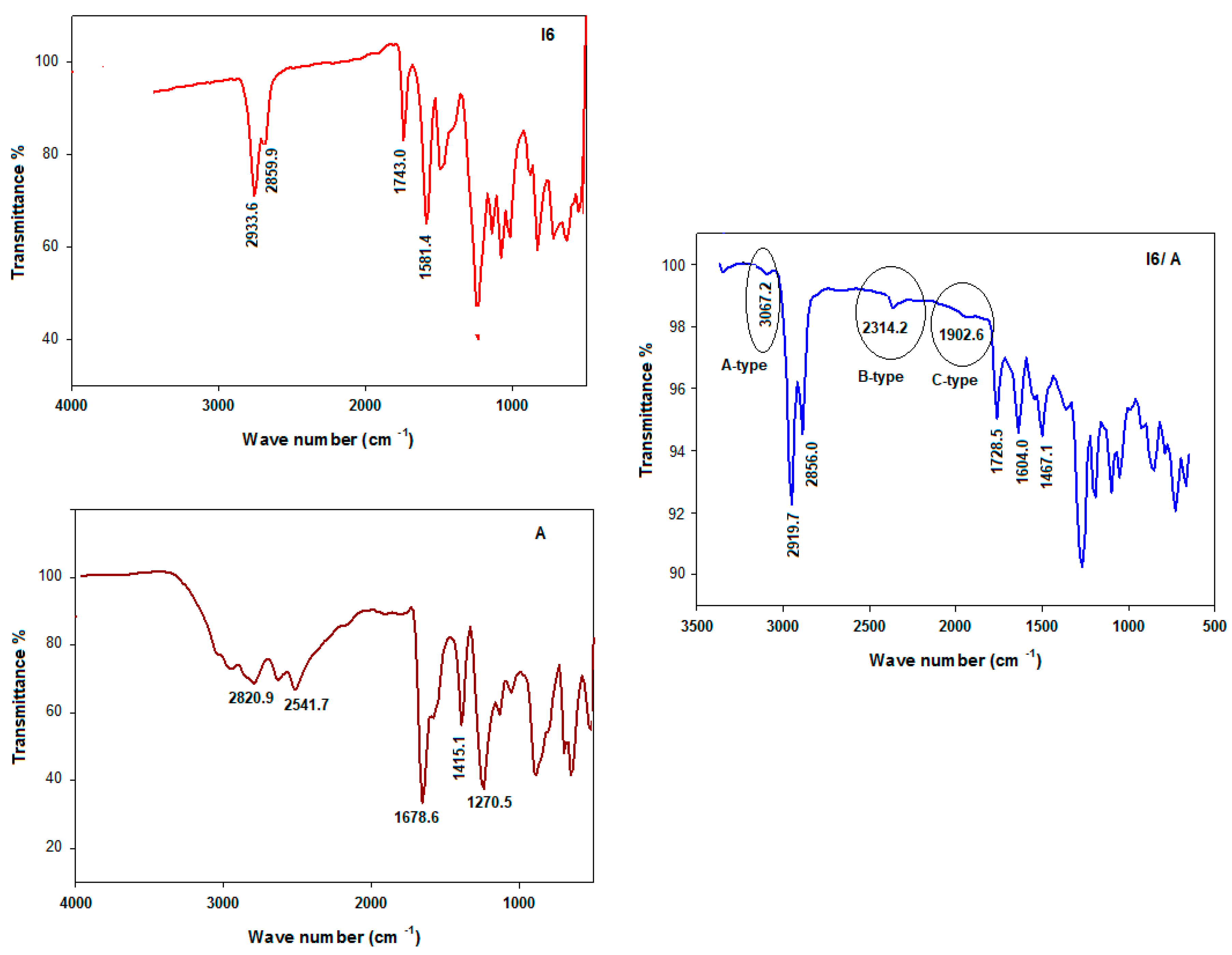

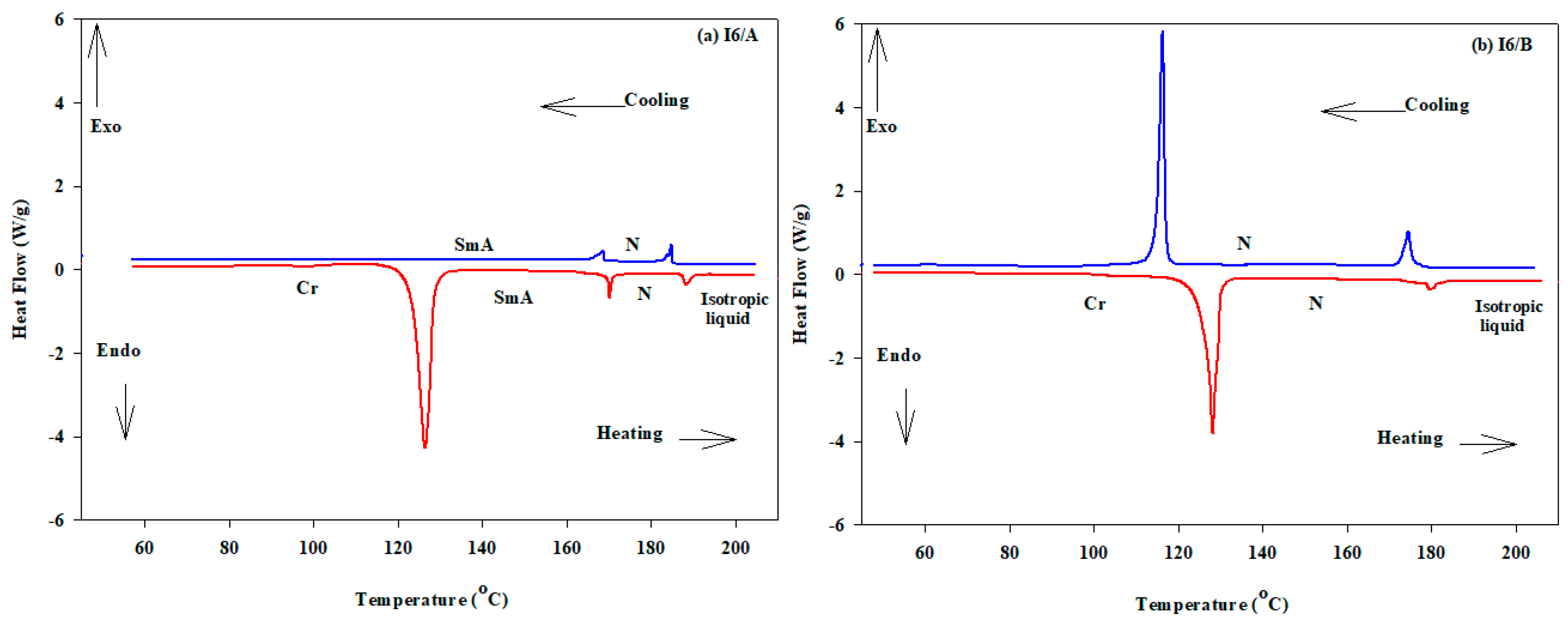
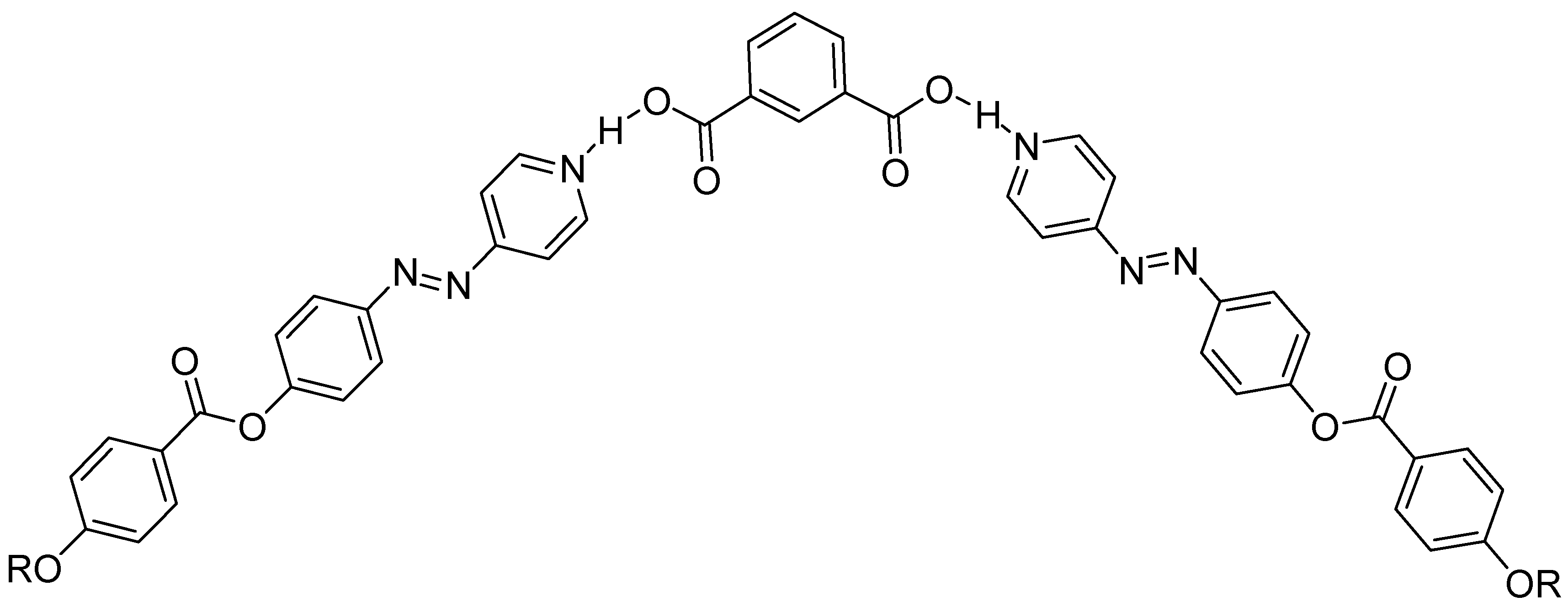
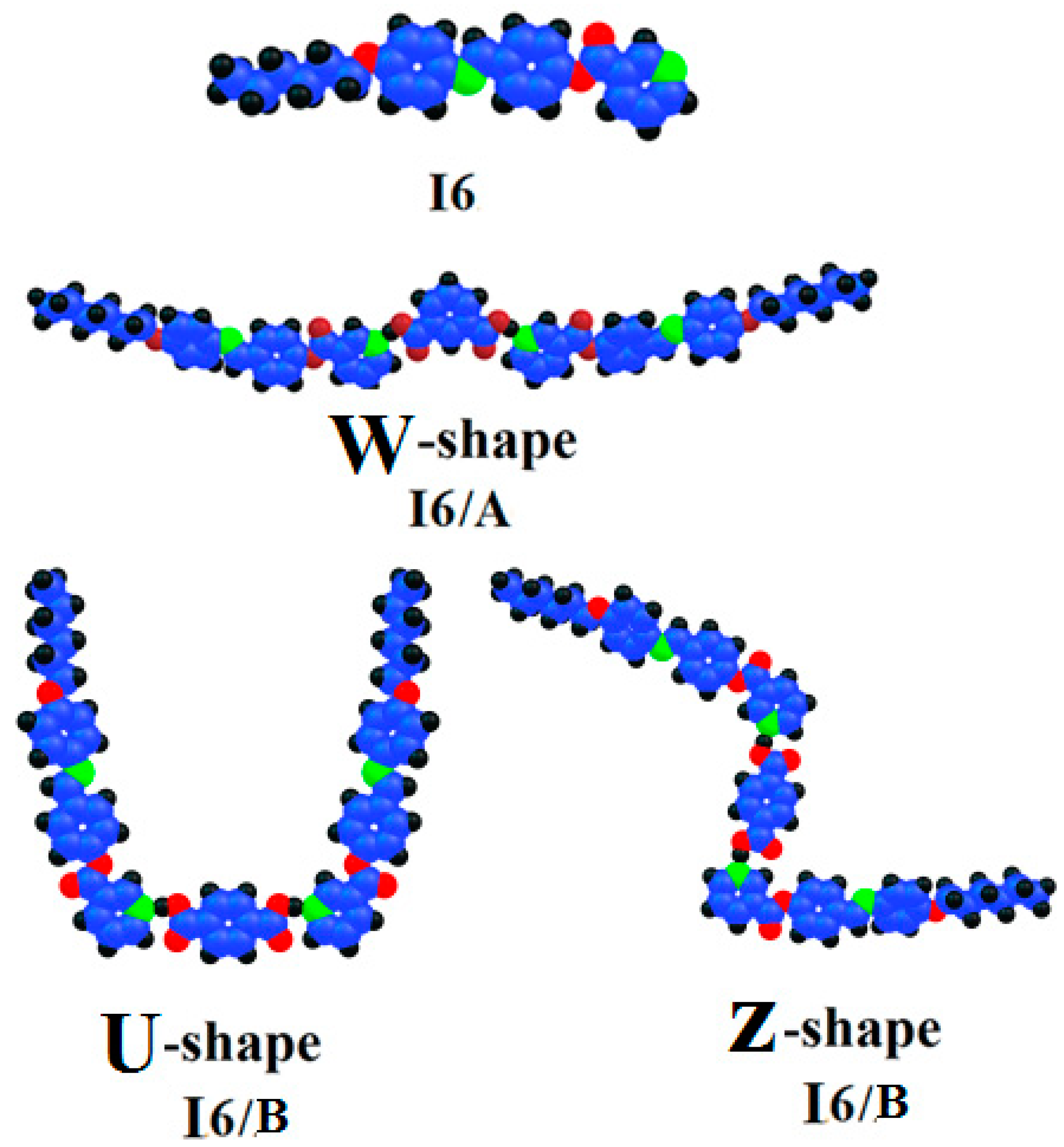
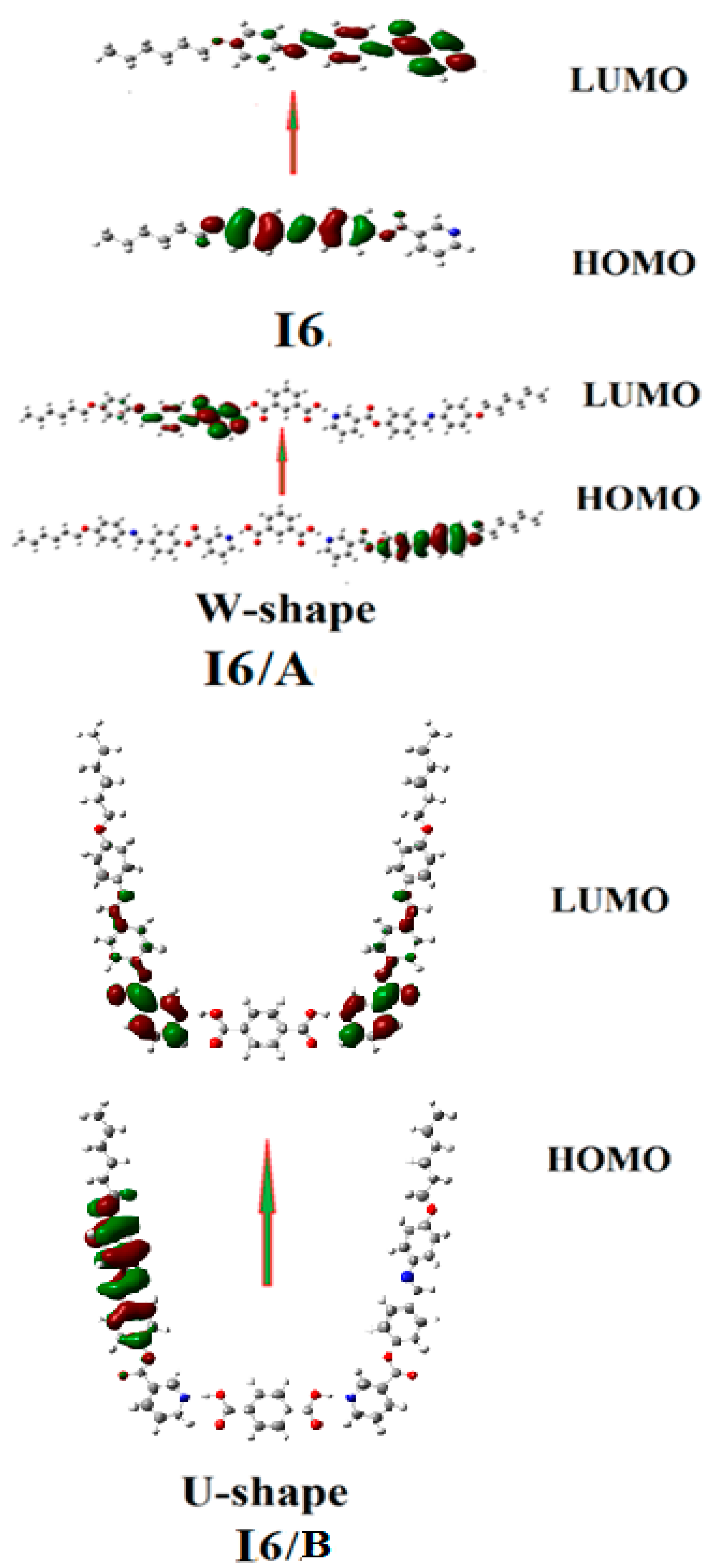
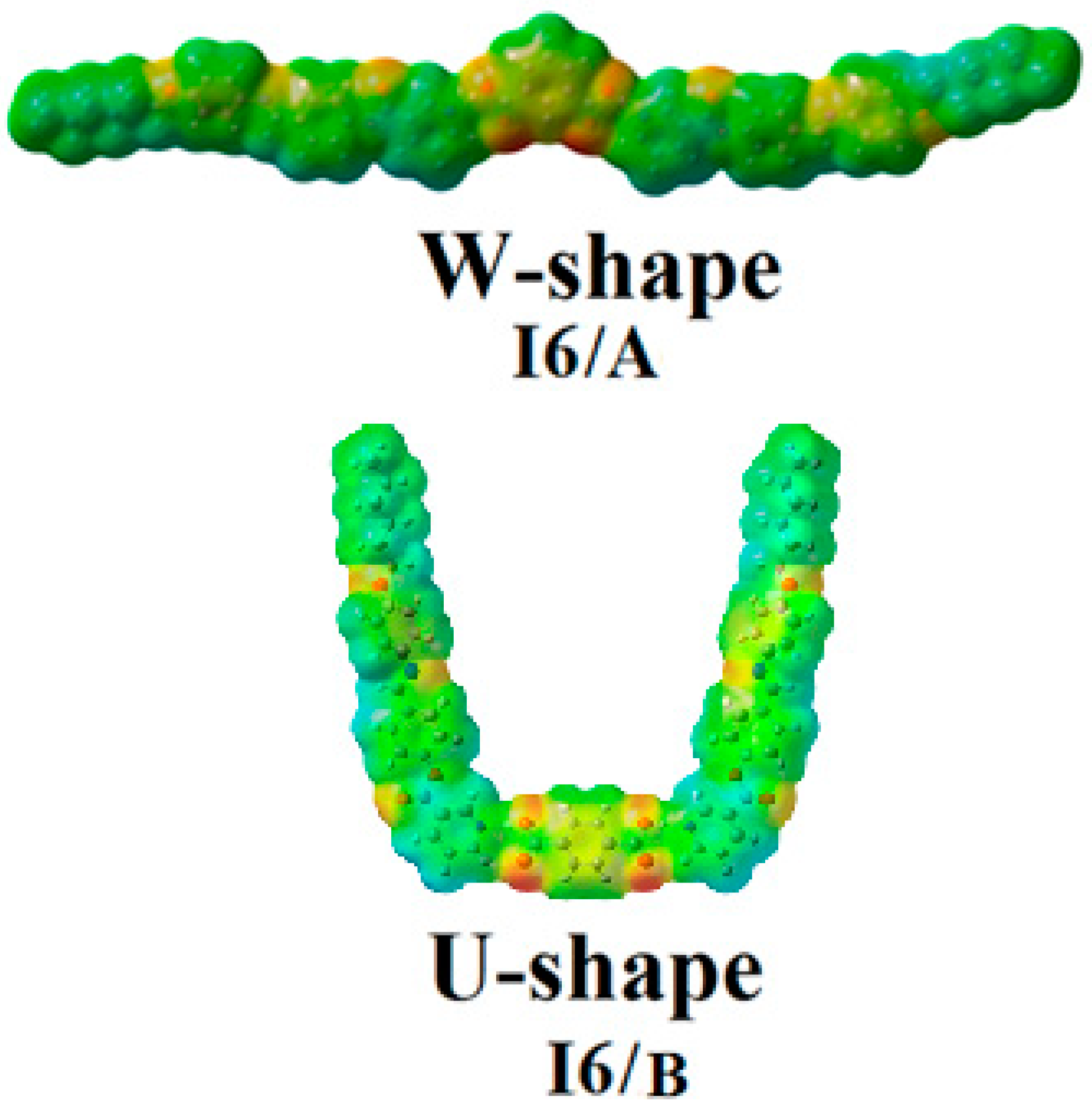
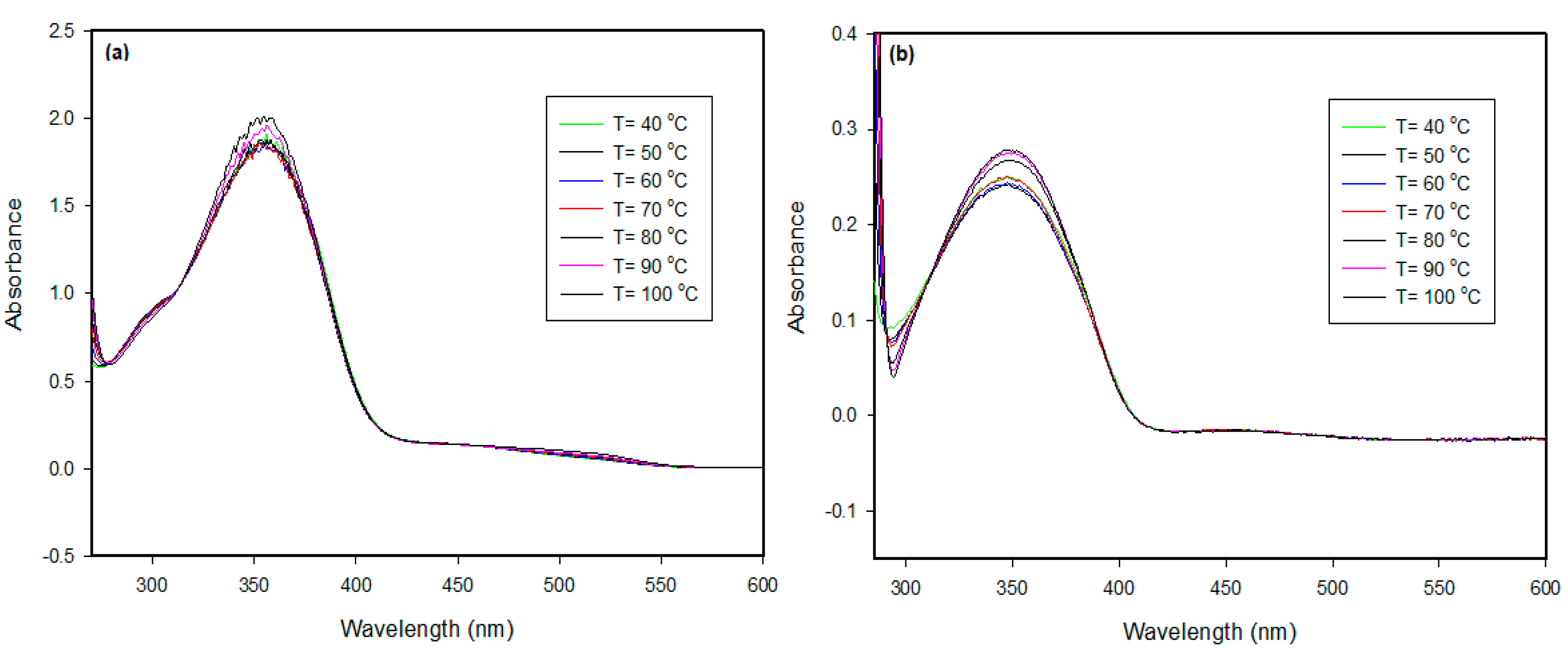
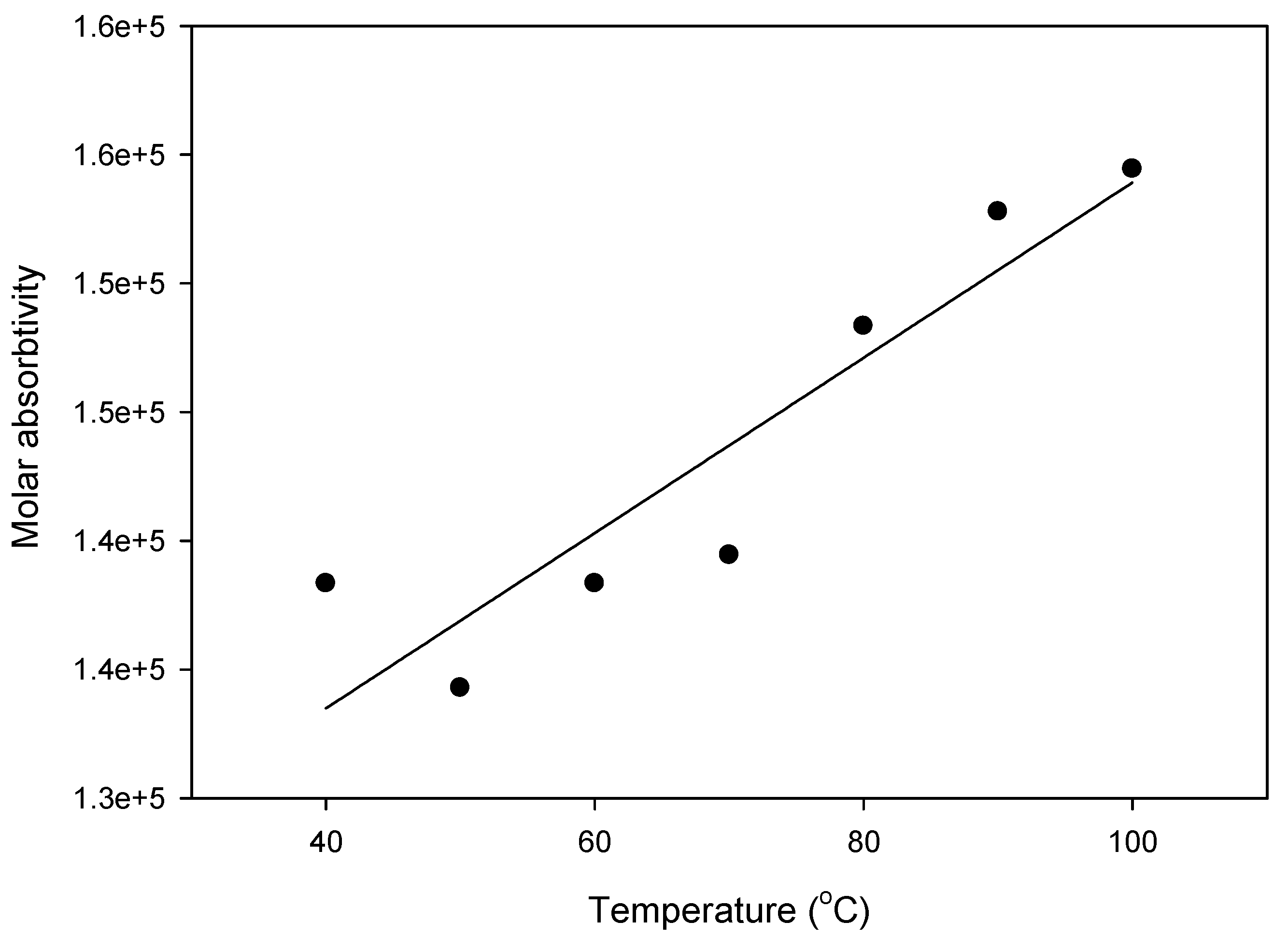
| System | TCr-SmA | ∆HCr-SmA | TCr-N | ∆HCr-N | TSmA-N | ∆HSmA-N | ∆SSmA-I/R | TN-I | ∆HN-I | ∆SN-I/R |
|---|---|---|---|---|---|---|---|---|---|---|
| I6 | − | − | 130.7 | 35.5 | − | − | − | 184.6 | 1.9 | 0.5 |
| I6/A | 126.9 | 52.8 | − | − | 170.6 | 2.3 | 0.6 | 186.9 | 1.0 | 0.3 |
| I6/B | − | − | 128.5 | 66.3 | − | − | − | 181.2 | 1.2 | 0.3 |
| Parameter | I6 | I6/A | I6/B | ||
|---|---|---|---|---|---|
| W-shape | U-shape | Z-shape | |||
| Ecorr | 0.461893 | 1.054168 | 1.054486 | 1.054400 | |
| ZPVE | −1302.959331 | −3215.234669 | −3215.236728 | −3215.236665 | |
| Etot | −1302.932846 | −3215.165279 | −3215.167518 | −3215.167424 | |
| H | −1302.931902 | −3215.164335 | −3215.166574 | −3215.166480 | |
| G | −1303.021887 | −3215.366005 | −3215.366299 | −3215.366334 | |
| Total µ | 4.88 | 6.81 | 6.6996 | 11.4971 | |
| Polarizability α | 356.7 | 836.1 | 830.10 | 830.73 | |
| Dimensions Å | Width (D) | 7.9 | 10.7 | 27.9 | 20.4 |
| Length (L) | 28.5 | 63.2 | 29.7 | 50.7 | |
| Aspect ratio (L/D) | 3.6 | 5.9 | 1.1 | 2.5 | |
| Parameter | I6 | I6/A | I6/B |
|---|---|---|---|
| ELUMO | −0.08468 | −0.09345 | −0.09454 |
| EHOMO | −0.21077 | −0.21429 | −0.21435 |
| ΔEHOMO-LUMO | 0.12609 | 0.12084 | 0.11981 |
| Hardness η =0.5 * ΔE | 0.06305 | 0.06042 | 0.05991 |
| Softness S=(ΔE)−1 | 7.93 | 8.27 | 8.34 |
© 2020 by the authors. Licensee MDPI, Basel, Switzerland. This article is an open access article distributed under the terms and conditions of the Creative Commons Attribution (CC BY) license (http://creativecommons.org/licenses/by/4.0/).
Share and Cite
Alnoman, R.B.; Hagar, M.; Ahmed, H.A.; Abu Al-Ola, K.A.; Naoum, M.M.; Al-Elati, F.; Abdullah Zaid, Y.; Alsharif, A.; Al-Juhani, Y.; Abulrhelh, A. Characterization of New H-Bonded Liquid Crystalline Complexes Based on Iminophenyl Nicotinate. Crystals 2020, 10, 499. https://doi.org/10.3390/cryst10060499
Alnoman RB, Hagar M, Ahmed HA, Abu Al-Ola KA, Naoum MM, Al-Elati F, Abdullah Zaid Y, Alsharif A, Al-Juhani Y, Abulrhelh A. Characterization of New H-Bonded Liquid Crystalline Complexes Based on Iminophenyl Nicotinate. Crystals. 2020; 10(6):499. https://doi.org/10.3390/cryst10060499
Chicago/Turabian StyleAlnoman, Rua B., Mohamed Hagar, Hoda A. Ahmed, Khulood A. Abu Al-Ola, Magdi M. Naoum, Fahad Al-Elati, Yousef Abdullah Zaid, Abdulrahman Alsharif, Yazeed Al-Juhani, and Abdulmjeed Abulrhelh. 2020. "Characterization of New H-Bonded Liquid Crystalline Complexes Based on Iminophenyl Nicotinate" Crystals 10, no. 6: 499. https://doi.org/10.3390/cryst10060499
APA StyleAlnoman, R. B., Hagar, M., Ahmed, H. A., Abu Al-Ola, K. A., Naoum, M. M., Al-Elati, F., Abdullah Zaid, Y., Alsharif, A., Al-Juhani, Y., & Abulrhelh, A. (2020). Characterization of New H-Bonded Liquid Crystalline Complexes Based on Iminophenyl Nicotinate. Crystals, 10(6), 499. https://doi.org/10.3390/cryst10060499







